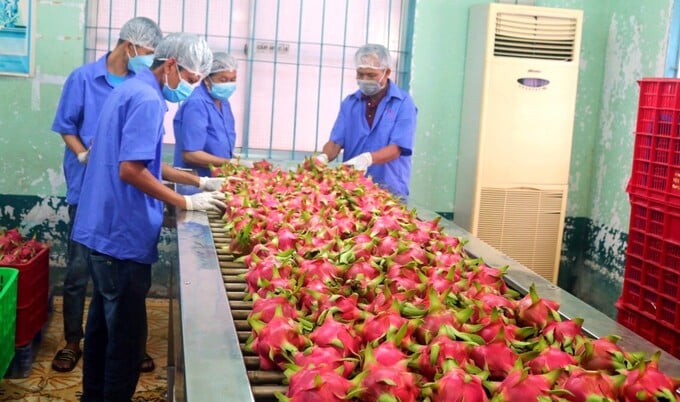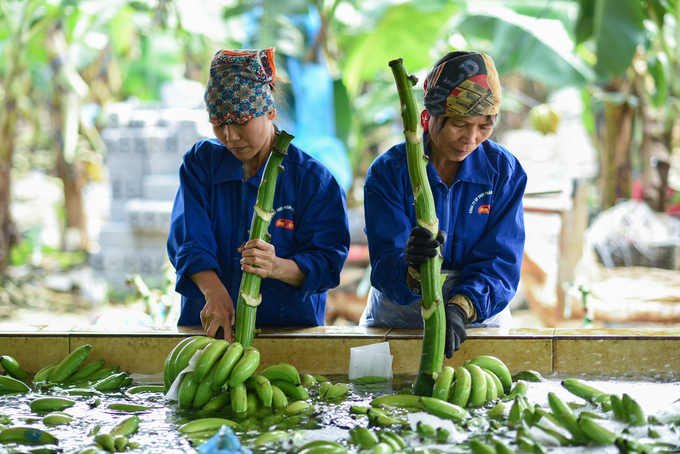
Deputy Minister of the Ministry of Agriculture and Rural Development Hoang Trung suggests that localities cooperate with the Ministry of Agriculture and Rural Development in closely managing and monitoring the area code of cultivation and the code of packaging facilities. Photo: Duy Thai.
The rate of post-issuance monitoring of codes is very low
"I want to emphasize the figures of nearly 7,000 cultivation areas and nearly 2,000 packaging facilities as highlights of the achieved results. These codes for cultivation areas, as well as the packaging facility codes have been accepted by importing countries, including demanding markets such as China, the United States, Japan... However, the rate of post-issuance monitoring of codes for new cultivation areas is only 40.8%, and for packaging facilities is 17%. These figures are too low compared to the practical requirement of annual monitoring," Deputy Minister of the Ministry of Agriculture and Rural Development, Mr. Hoang Trung emphasized at the conference to enhance state management of cultivation area codes and packaging facilities codes for export, held in Lang Son on August 24.
Deputy Minister Hoang Trung mentioned that recently, the Ministry of Agriculture and Rural Development and localities have received notifications of non-compliance with the requirements for plant quarantine and food safety of Vietnamese export batches to markets such as the EU, Taiwan, South Korea, China, Japan.
He suggested that various sectors and localities need to consistently engage with businesses on the notion that "issuing codes alone is not enough," and that inspection and monitoring must be conducted regularly.
The large number of violation notifications from importing countries as well as the situation of batches not meeting quarantine and food safety requirements are warning signs regarding the management of cultivation area codes and export packaging facilities. If these violations persist, it will seriously affect export sectors, erode the reputation of Vietnamese agricultural products, and may even lead to losing markets that have required significant efforts, time, and resources to access.

Until now, a considerable number of cultivation area codes and packaging facility codes have been issued, but the rate of inspection and supervision remains low. Photo: TL.
Mr. Hoang Khanh Duy, Deputy Head of the Management Board of Dong Dang Border Economic Zone (Lang Son), stated that China is increasingly raising its requirements for the quality of Vietnamese agricultural exports, especially concerning the control of harmful organisms on these products.
During inspection, when a case of harmful organisms is detected on a batch, the foreign side takes strict measures, demanding the entire batch to be returned to Vietnam. Sometimes, the import of such products is suspended for an extended period, as seen with Vietnamese chili peppers.
Representatives of the People's Committee of Lang Son Province mentioned that all border gates have instructed the deployment of sufficient functional forces to carry out customs clearance procedures, including plant quarantine stations under the Sub-department of Plant Protection of Region VII (Department of Plant Protection) directly performing professional tasks. Suitable locations have been arranged for inspection and verification activities.
Upon receiving notifications from plant quarantine stations about the need to handle Chinese plant quarantine objects (such as selection, elimination, requiring return for domestic consumption), the Border Management Center (a unit under the Management Board of Dong Dang Border Economic Zone - Lang Son) coordinates with functional forces at the border gates to temporarily halt customs clearance for the batch, providing the most favorable conditions for plant quarantine stations to effectively carry out their professional tasks in accordance with legal regulations.

Not adhering to regulations in the operations of cultivation areas and packaging facilities will lead to numerous repercussions for export activities. Photo: TL.
When batches are returned by China (due to reasons such as lack of agreement between Vietnamese and Chinese businesses, failure to meet export standards, or notification of violations by China), the Border Management Center promptly informs functional forces at the border gates to coordinate and guide enterprises on how to handle the situation. At the same time, they conduct dissemination efforts to help enterprises rectify and limit violations for subsequent batches.
Currently, in Lang Son Province, import and export activities take place at 6 border gates (Huu Nghi International Border Gate, Ga Railway Border Gate Dong Dang, Chi Ma Bilateral Border Gate, and the subsidiary border gates Tan Thanh, Coc Nam, Na Hinh). The main border gates for exporting agricultural products and fruits are Huu Nghi, Tan Thanh, and Coc Nam. The average number of cargo transport vehicles passing through these border gates in the province is about 1,100 vehicles per day (of which about 350 vehicles per day are for exports), peaking at over 1,200 vehicles per day (with around 500 vehicles per day for exports).
Strong measures will be applied for management
Deputy Minister Hoang Trung stated that the Ministry of Agriculture and Rural Development has proposed to the Government to draft two decrees: one decree on the management of cultivation area codes and packaging facilities for exporting vegetables and fruits; and another decree regulating administrative fines for violations of regulations related to cultivation area codes and packaging facilities.

The Ministry of Agriculture and Rural Development will implement strong measures to tighten the management of cultivation areas and packaging facilities for export that have been assigned identification codes. Photo: TL.
The Ministry of Justice is guiding the Ministry of Agriculture and Rural Development to initiate the construction and soon submit to the Government the draft of these two decrees. The Ministry of Agriculture and Rural Development has tasked the Department of Crop Production to lead the development of specific technical standards for each category of vegetables and fruits. This is to ensure that when harvesting products, the highest quality is achieved, primarily serving domestic consumers and expanding the export market.
“The Ministry of Agriculture and Rural Development will apply strong measures to tighten the management efforts. Henceforth, all agricultural products purchased from areas with cultivation area codes must guarantee quality, be free from harmful microorganisms, comply with food safety regulations, and be standardized in terms of packaging and appearance,” Deputy Minister, Mr. Hoang Trung stated.
On the sidelines of the conference, Mrs. Ngo Tuong Vy, CEO of Chanh Thu Fruit Import - Export Group Joint Stock Company, mentioned that legitimate businesses earnestly hope for prompt regulations and transparency regarding packaging facility codes and cultivation area codes.
“I strongly agree with the directives of Deputy Minister of Agriculture and Rural Development, Mr. Hoang Trung. We need a publicly accessible and transparent database for cultivation area codes and packaging facility codes. We can't sacrifice the reputation of an entire industry for personal, minor gains,” suggested Mrs. Vy.
Meanwhile, Mr. Luong Trong Quynh, Vice Chairman of the People's Committee of Lang Son Province, affirmed that the consistent principle of Lang Son Province is to always create the most favorable conditions to attract enterprises for investment in production, business, and import-export activities.
“With the determination to focus on economic development, in the upcoming time, Lang Son Province will continue to earnestly and systematically implement various tasks and solutions to promote import-export and cross-border trade activities with Guangxi (China), especially giving special attention to the exported Vietnamese agricultural products,” Mr. Quynh stated.
In the first 8 months of 2023 (from January 1, 2023, to August 17, 2023), the total import-export turnover declared at the Lang Son Customs Department reached over 3.5 billion USD (exports amounted to over 1.951 billion USD, and imports amounted to over 1.556 billion USD).
Among these figures, the export of agricultural and fruit products through the Lang Son Province reached around 1.6 million tons, with a value of approximately 1.2 billion USD. Some major exported fruit products include: Dragon fruit with 390,000 tons, valued at 110 million USD; durian with 215,000 tons, valued at 650 million USD; jackfruit with 250,000 tons, valued at 90 million USD; mango with 185,000 tons, valued at 40 million USD; fresh lychee with 37,000 tons, valued at around 5.5 million USD; watermelon with 120,000 tons, valued at 30 million USD; and banana with 25,000 tons, valued at 5 million USD.
Authors: Van Viet - Nam Nguyen
Translated by Nguyen Hai Long
(Nguồn: Báo Nông nghiệp Việt Nam)




